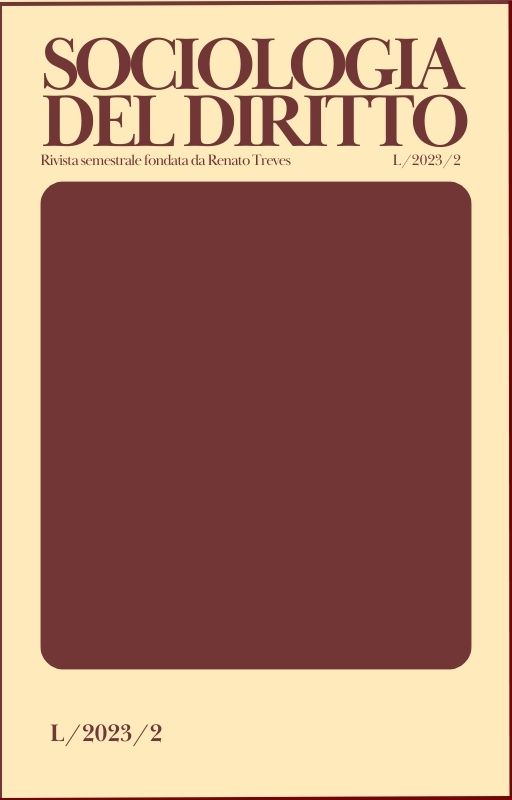Essays
Published 2023-12-05
Keywords
- climate change,
- legal time,
- private law,
- property,
- commons
Copyright (c) 2023 Veronica Pecile

This work is licensed under a Creative Commons Attribution-ShareAlike 4.0 International License.
Abstract
This article presents a temporal approach to law as potentially innovative for legal theory and practice. It posits that an analysis of the relationship between law and time is essential in order to decentre the subject of rights as conventionally conceived in Western modern law and to develop legal instruments capable of recognising networks, connections and assemblages. The current phase of climate change and ecological crisis is interpreted as a context in which it is possible to rethink the fundamental forms of modern law, and of private law in particular, in order to allow non-linear and non-human temporalities to enter legal thought and technique.
Downloads
Download data is not yet available.
References
- Bakhtin, M., (1981), The Dialogic Imagination: Four Essays, Austin, TX, University of Texas Press.
- Blank, Y., Rosen-Zvi, I., (2010), The Spatial Turn in Legal Theory, HAGAR Studies in Culture, Polity and Identities, 10, 1, pp. 37-60. DOI: https://ssrn.com/abstract=2937221.
- Blomley, N., (1994), Law, Space, and the Geographies of Power. New York e Londra, Guilford Press.
- Chakrabarty, D., (2021), The Climate of History in a Planetary Age, Chicago, IL, University of Chicago Press.
- Code de l’environnement, (2022), https://www.legifrance.gouv.fr/codes/article_lc/LEGIARTI000045213769 (Data di accesso: 6/11/2023).
- Commissione Rodotà, (2010), Relazione per la modifica delle norme del codice civile in materia di beni pubblici, http://www.senato.it/service/PDF/PDFServer/DF/217244.pdf (Data di accesso: 7/09/2023).
- Crutzen, P., Stoermer, O., (2000), The Anthropocene, Global Change Newsletter, 41, 1, pp. 17-18.
- Cullmann, O., [1964] (2018), Christ and Time: The Primitive Christian Conception of Time and History, 3rd Edition, Eugene, OR, Wipf and Stock Publishers.
- Grear, A., (2015), Deconstructing Anthropos: A Critical Legal Reflection on ‘Anthropocentric’ Law and Anthropocene ‘Humanity’, Law and Critique, 26, 3, pp. 225-49.
- Greenhouse, C.J., (1989), Just in Time: Temporality and the Cultural Legitimation of Law, The Yale Law Journal, 98, 8, pp. 1631-51.
- Greenhouse, C.J., (1996), A Moment’s Notice: Time Politics Across Cultures, Ithaca, NY, Cornell University Press.
- Knop, K., Riles, A., (2017), Space, Time, and Historical Injustice: A Feminist Conflict-of-Laws Approach to the Comfort Women Agreement, Cornell Law Review, 102, 4, pp. 853-928.
- Koselleck, R., (1985), Futures Past: On the Semantics of Historical Time, Cambridge, MA, MIT Press.
- Kracauer, S., (1966), Time and History, History and Theory, 6, pp. 65-78.
- Jasanoff, S., (2010), A New Climate for Society, Theory, Culture & Society, 27, 2-3, pp. 233-53. DOI: https://doi.org/10.1177/0263276409361497.
- Latour, B., [1993] (1995), Nous n’avons jamais été modernes: Essai d’anthropologie symétrique. Traduzione italiana Non siamo mai stati moderni, Milano, Elèuthera.
- Marella, M.R., (2021), An Anthropology of the Legal Subject: On the Transformation of a Legal Concept, Osservatorio del diritto civile e commerciale, 1, pp. 71-104.
- Massey, D., (2005), For Space, London, Sage.
- Menga, F., (2021). L’emergenza del futuro. I destini del pianeta e le responsabilità del presente, Roma, Donzelli.
- Merino, R., (2018), Reimagining the Nation-State: Indigenous Peoples and the Making of Plurinationalism in Latin America, Leiden Journal of International Law, 31, 4, pp. 773-92.
- Monterossi, M.W., (2020), L’orizzonte intergenerazionale del diritto civile. Tutela, soggettività, azione, Pisa, ETS Edizioni.
- Napoli, P., (2014), Indisponibilité, service public, usage. Trois concepts fondamentaux pour le ‘commun’ et les ‘biens communs’, Tracés. Revue de Sciences humaines, 27, pp. 211-33. DOI : https://doi.org/10.4000/traces.6139.
- Napoli, P., (2015), Il Comune: un’appartenenza non proprietaria, Alfabeta2, http://www.alfabeta2.it/2015/04/25/il-comune-unappartenenza-non-proprietaria/ (data di accesso: 7/09/2023).
- Nuzzo, L., (2011), A Dark Side of the Western Legal Modernity: The Colonial Law and its Subject, Zeitschrift für Neuere Rechtsgeschichte, 33, 3-4, pp. 205-22.
- O’Donnell, E.L., Talbot-Jones, J., (2018), Creating legal rights for rivers: lessons from Australia, New Zealand, and India, Ecology and Society, 23, 1. DOI: https://doi.org/10.5751/ES-09854-230107.
- Orestano, R., (1968), Il problema delle persone giuridiche in diritto romano, Torino, Giappichelli.
- Pecile, V., (2021), The Legal Field as Battleground for Social Struggle: Reclaiming Law from the Margins, Oñati Socio-Legal Series, 11, 6, pp. 187-208. DOI: https://doi.org/10.35295/osls.iisl/0000-0000-0000-1248.
- Petersmann, M.C., (2022), Life Beyond the Law – From the ‘Living Constitution’ to the ‘Constitution of the Living’, Zeitschrift Für Ausländisches Öffentliches Recht Und Völkerrecht / Heidelberg Journal of International Law, 82, 4, pp. 769-800. DOI: https://doi.org/10.17104/0044-2348-2022-4-769.
- Richardson, B.J., (2017), Doing Time-The Temporalities of Environmental Law, in Kotzé, L., ed., Environmental Law and Governance for the Anthropocene, London, Bloomsbury Publishing, pp. 55-74.
- Scott, J.C., (1998), Seeing like a State: How Certain Schemes to Improve the Human Condition Have Failed, New Haven, CT, Yale University Press.
- Spanò, M., (2019), Making the Multiple: Towards a Trans-Subjective Private Law, The South Atlantic Quarterly, 118, 4, pp. 839-855.
- Spanò, M., (2020), ‘Perché non rendi poi quel che prometti allor?’ Tecniche e ideologie della giuridificazione della natura, in Spanò, M, ed., L’istituzione della natura, Macerata, Quodlibet, pp. 103-24.
- Spanò, M., (2022), Fare il molteplice: il diritto privato alla prova del comune, Turin, Rosenberg & Sellier.
- Stone, C.D., (1972), Should Trees Have Standing? Toward Legal Rights for Natural Objects, Southern California Law Review, 45, pp. 450-501.
- Tanasescu, M., (2022), Understanding the Rights of Nature: A Critical Introduction, Bielefeld, Transcript Verlag.
- Terré, F., (2012), Du juridique et du social, Parigi, Mare et Martin.
- Thomas, Y., (2002), La valeur des choses. Le droit romain hors la religion, Annales. Histoire, Sciences Sociales, 57, 6, pp. 1431-62.
- Thompson, E.P., (1967), Time, Work-Discipline, and Industrial Capitalism, Past & Present, 38, pp. 56-97.
- Valverde, M., (2014), “Time Thickens, Takes on Flesh”: Spatiotemporal Dynamics in Law, in Braverman, I., Blomley, N., Delaney, D., Kedar, A., eds., The Expanding Spaces of Law, Redwood City, CA, Stanford University Press, pp. 53-76.
- Valverde, M., (2015), Chronotopes of Law: Jurisdiction, Scale and Governance, New York, Routledge.

